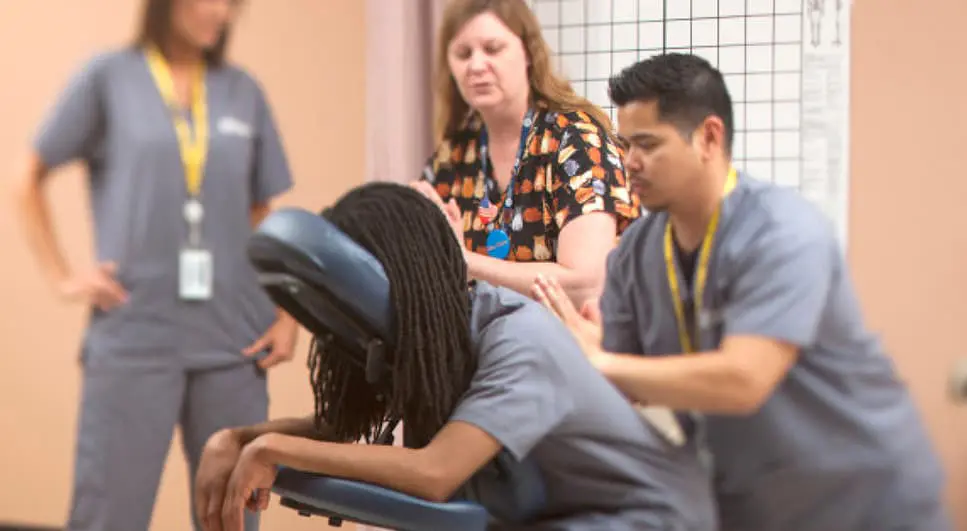 As a busy college student, you recognize the value of self-care but may still struggle to relax. Massage may help. This brings an intentional approach to self-care, in which you purposefully set aside an hour to focus on relaxation, rejuvenation, and recovery. Beyond this, a massage is worth booking because, simply put, it’s an enjoyable experience.
As a busy college student, you recognize the value of self-care but may still struggle to relax. Massage may help. This brings an intentional approach to self-care, in which you purposefully set aside an hour to focus on relaxation, rejuvenation, and recovery. Beyond this, a massage is worth booking because, simply put, it’s an enjoyable experience.
Deciding whether to get a massage may seem easy, but that is only the beginning. Just as important is choosing the right type of massage. This can be surprisingly difficult, as there are many massage techniques and many ways to tailor this experience. We’re here to help. Below, we’ve identified several types of massage and their impressive (yet often different) benefits.
Why Massage Therapy Is Essential for Students
Mental health is a major area of concern for today’s students, who may struggle to manage academic demands along with work and other obligations. Add uncertainty during a time of transition, and you have a recipe for increased stress.
While there are many strategies for dealing with these pressures, a student wellness massage is one of the most appealing, as it does not add to your mental burden. All you need is to book an appointment. Your massage therapist will take care of the rest.
Massage therapy is also essential from a physical perspective. After all, today’s college students spend long hours at their computers or examining textbooks, often with poor posture. Despite good intentions to sit up straight or take stretch breaks, soreness, and stiffness are common problems. A simple massage can loosen tight muscles and improve alignment, all while addressing chronic discomfort.[1]
Exposure to this practice could also prove helpful for students in clinical programs, who may be more likely to recommend massage to future patients if they, themselves, have benefited from massage therapy. Research even suggests that massage may even have a positive impact on cognitive function.[2] Between potential benefits related to focus, cognition, and stress management, it’s possible that massage could ultimately improve academic performance.
Understanding Different Types of Massages and Their Benefits
Research reveals a myriad of therapeutic massage benefits, including everything from stress relief to reduced muscle tension, improved flexibility, and even better sleep.[3] However, different massages deliver different advantages. Some are more closely tied to athletic performance or injury prevention, while others focus primarily on mental health concerns.
There truly is something for everyone, but to get the most out of your massage experience, you will want to feel confident that your preferred massage style reflects your unique goals and preferences.
So, what exactly is the best massage for stress relief? The answer to this may call for some self-reflection. Take time to understand where you’re struggling, what you require (both physically and mentally), and how massage might be the answer. If you can pinpoint two or three specific concerns, you can easily find a massage style that promises to correct these problems.
As you look into different massage strategies, you will likely come across a few tried-and-tested solutions. Below, we have identified common styles and techniques, revealing what sets these strategies apart and which specific benefits they promise for massage-seeking students.
Swedish Massage – The Ultimate Relaxation Choice
Arguably the best massage for stress relief, Swedish massage is what many people think of when they picture a ‘classic’ massage. This technique aims to promote general relaxation over deep or targeted tissue manipulation. This is a great option when you don’t have a specific physical concern to attend to, but rather want to indulge in a deeply relaxing experience.
This practice’s name derives from its Swedish origins: it was developed by a Swedish physiotherapist, Per Henrik Ling, who, in addition to promoting massage, advocated for a movement-focused lifestyle to promote physical health and overall well-being.[4]
Dutch physical therapist Johan Mezger expanded on this practice, however, developing the targeted techniques for which Swedish massage is currently known:[5]
- Effleurage: gliding strokes
- Petrissage: kneading
- Friction: circular motions
- Tapotement: tapping motions
- Vibration: shaking motions
Deep Tissue Massage – For Muscle Recovery and Pain Relief
Whether you’re dealing with chronic pain or an intense exercise regimen, a deep-tissue massage could bring about lasting physical relief. This method looks a lot different from relaxation-focused Swedish massage, instead shifting the focus to specific physical concerns or complaints. This massage strategy uses intense or focused techniques to relieve deep tension.[6]
In general, firmer strokes can be expected when experiencing a deep-tissue massage. The massage therapist moves beyond basic relaxation techniques in an effort to reach underlying layers of muscle. To that end, massage therapists must draw on a deep understanding of anatomy and physiology to properly target various muscle groups.
During a deep-tissue massage, sustained pressure (or static pressure) may be applied to help break down muscle adhesions and release tension. This may be alternated with back-and-forth or circular motions referred to as friction, with cross-fiber friction, in particular, promising to effectively target muscle fibers.[7] A technique known as muscle stripping can address tension with deep or gliding pressure.
Sports Massage – Boosting Performance and Recovery
Many college students enjoy participating in intense recreational activities, and while these can provide significant physical, mental, and even social benefits, soreness and injuries are likely. Sports massage can bring about much-needed relief and may even help improve athletic performance.[8]
While sports massage shares much in common with deep-tissue massage (including an emphasis on intense techniques), this is tailored to reflect the unique needs of athletes, aiming not only for relief from chronic pain or tension, but also for injury prevention and improved flexibility. As such, sports massages may draw on techniques from both Swedish and deep-tissue massage, but are applied in a way that feels specific to athletes and their specific goals.
Reflexology – Stress Relief Through Foot and Hand Pressure Points
Sometimes referred to as regional or zone therapy, reflexology shifts the focus from working directly on muscles to stimulating various pressure points on the hands, feet, or even the ears. The National Center for Complementary and Integrative Health explains that these points “match up with certain other parts of the body” and that such connections can spark healing in areas throughout the body.[9] Commonly addressed concerns include back pain, constipation, and headaches.
During reflexology sessions, many different techniques can be used to help target corresponding organs or body parts that require attention. Thumb and finger walking, for example, apply gentle and rhythmic pressure, while rotational movements could release tension or improve circulation.
People describe this experience as feeling light or relaxing, with some also referencing a unique feeling of energy flowing throughout the body. Research backing reflexology remains limited, but some studies suggest that it may help alleviate certain breast cancer symptoms or could even alleviate the prickling sensations associated with multiple sclerosis.[10]
Hot Stone Massage – A Deep Relaxation Experience
Emphasizing relaxation, hot stone massage involves placing heated or cooled stones directly on the skin. These stones are smooth and may be heated in water before being applied to areas of concern, including, in many cases, stones placed along the spine. This practice holds ancient origins but remains popular to this day because it is so deeply relaxing.
In addition to strategic placement, hot stone massages may involve gliding or rocking motions that promote further relaxation. For example, a technique known as “flip and glide” helps stones deliver sustained warmth while also applying gentle pressure to help relieve tension.[11] Static pressure, vibrations, and cross-fiber friction can all be applied when using hot stones.
How to Choose the Right Massage for Your Lifestyle and Health Goals
Now that you understand which types of massage are available, it’s time to choose an approach that feels relevant to your unique goals and preferences. There is no ‘right’ answer, but depending on your current concerns, it might help review broad trends or qualities:
- For Stress and Mental Relaxation: Swedish massage, reflexology
- For Muscle Tension and Pain Relief: Deep-tissue massage, hot stone massage
- For Athletic Recovery and Injury Prevention: Sports massage, deep-tissue massage
- For Quick Stress Relief on a Budget: Reflexology, chair massage
As you explore different massage styles or techniques, keep in mind that you do not need to feel limited to just one approach. Many people book different types of massages to address different concerns. For example, the same person could use deep-tissue massage for pain relief while also booking the occasional Swedish massage to manage stress in the lead-up to exams.
Tips for Maximizing Your Massage Experience
You’ve booked your student wellness massage and are excited to experience the ultimate in relaxation and stress relief. How you prepare for this experience could make a world of difference, so you will want to plan carefully to ensure that you make the most of this amazing opportunity.
How to Prepare for a Massage Session
As your massage approaches, start taking extra steps to improve your overall health and comfort. This begins with keeping hydrated, which can boost circulation and may even make it easier to manipulate targeted muscles. Dehydration could leave muscles feeling rigid, making it more difficult to accomplish the main goal of the massage, which is relieving pain or tension.[12]
Next, consider your outfit for the day of the massage. This could influence your comfort and ability to relax. You ultimately have the final say regarding what you wear, so consider what will make you feel most physically comfortable and mentally at ease. Aim for loose-fitting clothes that are easy to remove, if desired.
Finding Affordable Massage Options for Students
The extraordinary benefits of massage do not need to feel financially out of reach. Many reasonably priced options allow you to relax without breaking the bank. Many students work with aspiring massage therapists, who may need extra practice hours before they are ready to take the Massage & Bodywork Licensing Examination (MBLEx) and enter the field.[13]
If you’re truly passionate about massage and eager to build its benefits into your everyday life, consider pursuing a career in massage therapy. This allows you to bring the power of massage to a wider community and will also introduce you to the most accomplished and inspiring individuals in this critical field. With the right training, you can develop the targeted skills needed to deliver relief and relaxation, all while pursuing a career that delivers deep personal fulfillment.
Embrace the Power of Massage
Ready to take your passion for wellness to the next level? Explore Carrington College’s Massage Therapy program and turn your interest in relaxation and healing into a rewarding career. Apply today and start making a difference — one massage at a time!
Sources:
[1] American Massage Therapy Association. “25 Reasons to Get a Massage.” https://www.amtamassage.org/find-massage-therapist/25-reasons-to-get-a-massage/
[2] Utli, H. “Effects of Massage Therapy on Clinical Symptoms of Older People.” Journal of Education and Research in Nursing. https://jag.journalagent.com/jern/pdfs/JERN_19_1_103_107.pdf
[3] American Massage Therapy Association. “The Value of Massage Research.” https://www.amtamassage.org/publications/value-of-massage-research/
[4] Melnick, S. “Per Henrik Ling – Pioneer of Physiotherapy and Gymnastics.” European Journal of Physical Education and Sport Science. https://www.calameo.com/read/00470581698824662befc
[5] Massage Magazine. “What’s a Swedish Massage and Why Should Every Therapist Offer It?” https://www.massagemag.com/magazine-2002-issue100-history100-24026/
[6] DeBusk, C. “An In-Depth Guide to Deep Tissue Massage.” Massage Magazine. https://www.massagemag.com/guide-to-deep-tissue-massage-89900/
[7] Wunderlich, S. “Parameters of Pain.” American Massage Therapy Association. https://www.amtamassage.org/publications/value-of-massage-research/
[8] American Massage Therapy Association. “Massage Therapy for Those Who Exercise.” https://www.amtamassage.org/about/position-statements/massage-therapy-for-those-who-exercise/
[9] National Center for Complementary and Integrative Health. “Reflexology.” https://www.nccih.nih.gov/health/reflexology
[10] Zinkin, H. “Reflexology Reduces Stress/Pain, Increases Energy During Breast Cancer RT.” Cancer Network. https://www.cancernetwork.com/view/reflexology-reduces-stress-pain-increases-energy-during-breast-cancer-rt
[11] Mayrhofer, H. “Advanced Techniques with Massage Stones.” Massage Magazine. https://www.massagemag.com/advanced-techniques-with-massage-stones-10347/
[12] Dittrich, J. “You Tell Your Clients to Drink Water — But Do You?” Massage Magazine. https://www.massagemag.com/you-tell-your-clients-to-drink-water-but-do-you-123953/
[13] Federation of State Massage Therapy Boards. “Massage and Bodywork Licensing Examination (MBLEx).” https://fsmtb.org/mblex-process-requirements-2/



